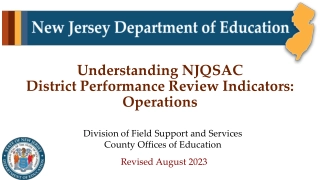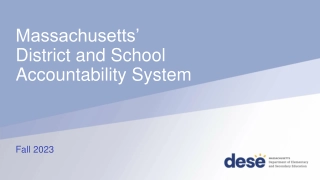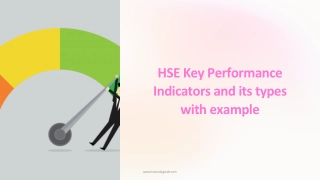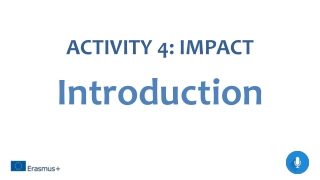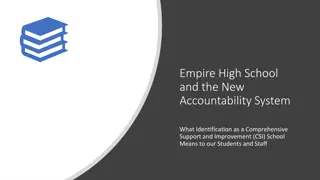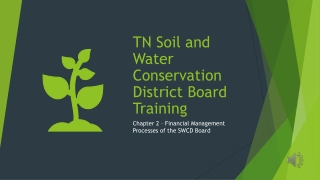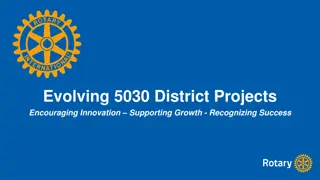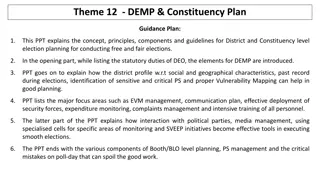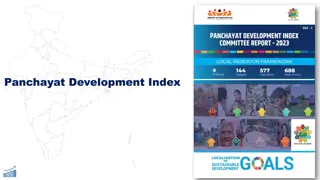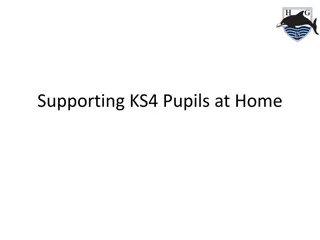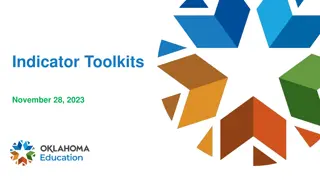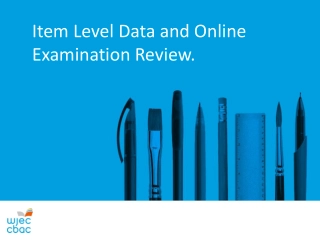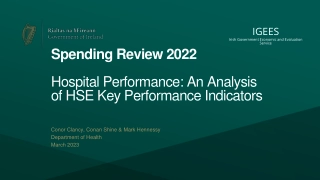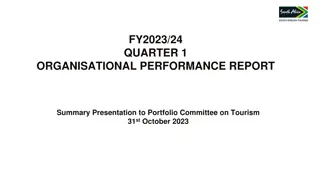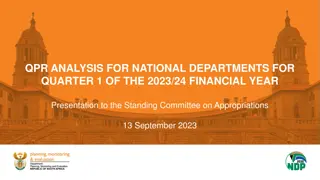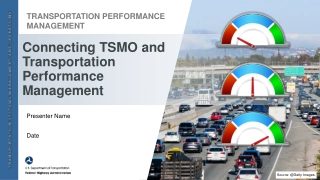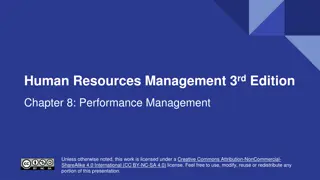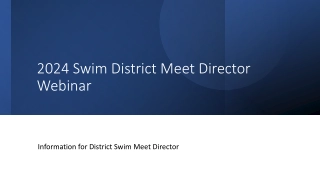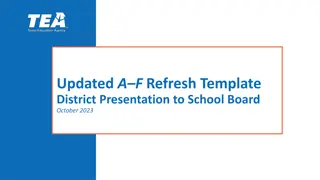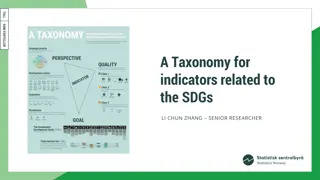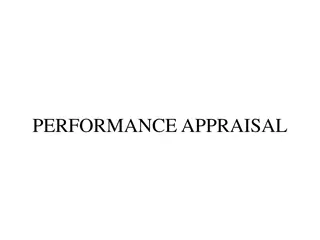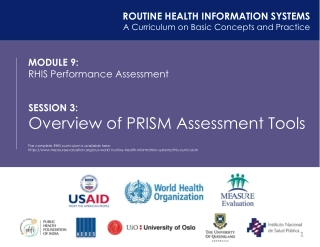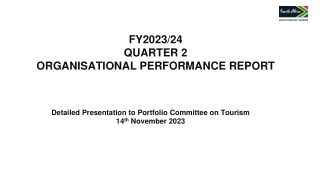Understanding NJQSAC District Performance Review Indicators
NJQSAC requires public school districts in New Jersey to complete a District Performance Review (DPR) comprising self-assessment tools measuring compliance with quality performance indicators in areas like instruction, fiscal management, governance, operations, and personnel. The District NJQSAC Committee includes key members like the Chief School Administrator, teachers, and board members. Districts must submit required documents through Homeroom for the DPR, ensuring a thorough and efficient education system. Submission due date is November 15th.
Understanding NJQSAC District Performance Review Indicators
PowerPoint presentation about 'Understanding NJQSAC District Performance Review Indicators'. This presentation describes the topic on NJQSAC requires public school districts in New Jersey to complete a District Performance Review (DPR) comprising self-assessment tools measuring compliance with quality performance indicators in areas like instruction, fiscal management, governance, operations, and personnel. The District NJQSAC Committee includes key members like the Chief School Administrator, teachers, and board members. Districts must submit required documents through Homeroom for the DPR, ensuring a thorough and efficient education system. Submission due date is November 15th.. Download this presentation absolutely free.
Presentation Transcript
Understanding NJQSAC District Performance Review Indicators Instruction and Program Division of Field Support and Services County Offices of Education Revised August 2023
NJQSAC District Performance Review (DPR) As part of the comprehensive review, to ensure a thorough and efficient education for all students by NJQSAC, each public school district shall complete a District Performance Review (DPR), which consists of a self-assessment tool that measures the public school district s compliance with the weighted quality performance indicators in the five identified areas of school district effectiveness. N.J.A.C. 6A:30. 1. Instruction and Program 2. Fiscal management 3. Governance 4. Operations 5. Personnel 2
District NJQSAC Committee As a reminder, the NJQSAC Committee must be comprised of the following members (N.J.A.C. 6A: 30-3.2): Chief School Administrator District Administrative Staff Member Teacher School Business Administrator Curriculum and Instruction Representative Local Collective Bargaining Representative District Board of Education Member 3
NJQSAC District Performance Review (DPR) Districts will complete a full self-assessment and submit through homeroom the three required documents (N.J.A.C 6A: 30-3.3): DPR Excel file PDF file of signed Declaration page PDF file of board resolution approving the DPR for submission Submission is not complete unless all three files are uploaded. 4
District Submission Upload the three NJQSAC documents via the NJDOE Homeroom Website Submission is not complete unless all three documents are uploaded. The staff member responsible for uploading needs a username and password which can be obtained from the district s Web User Administrator (WUA). To facilitate the submission, the WUA can also upload the files. 5
District Submission Due Date Upload the three (3) documents on or before November 15th 6
New Jersey Quality Single Accountability User Manual The New Jersey Quality Single Accountability Continuum (NJQSAC) User Manual (User Manual) contains guidance for each of the five areas of NJQSAC. It identifies each indicator in the performance area and provides the following information: Points assigned to each indicator; Purpose of the Indicator so all involved understand the requirements; Documentation for Verification which identifies the documents to be considered in indicator review; Department Review Process which explains how, where and what will be done to see if the district is compliant; and Verification of Indicator Compliance which explains the criteria for compliance with the indicator. 7
NJQSAC Instruction & Program (I&P) District Performance Review (DPR) The purpose of the I&P DPR is to measure a district s capacity to provide a thorough and efficient education that is compliant with New Jersey Education statutes and regulations. The evidence reviewed demonstrates how the district: Supports and monitors student achievement and growth (academic progress) Monitors and facilitates student progress towards graduation (graduation rate) Implements strategies and interventions encouraging student attendance (district s chronic absenteeism rate) Aligns curriculum to New Jersey Student Learning Standards (NJSLS) and demonstrates compliance with N.J.A.C. 6A:8-3 Provides equity and access to learning Provides a coordinated system of support 8
An Overview of Data-Specific Indicators 1-7 Achievement Score (1 of 2) Total of 60 Points Indicators 1 through 3 - Student Performance on NJSLS Assessments These indicators illustrate the school district s achievement scores based on the last full administration of state assessment in ELA, Mathematics and Science. The scores are based on overall and student subgroup performance. Indicators 4 and 5 - Student Growth on ELA and Mathematics Assessments These indicators illustrate the school district s academic progress in ELA and Math based on averaging the median Student Growth Percentile (mSGP) of all students with the average of all subgroups mSGPs. (see User Manual). Indicator 6 - Graduation Rate This indicator illustrates the school district s state graduation rate as an average of the four-year and five-year adjusted cohort graduation rate. It is calculated by averaging the combined graduation rate of all students with the average of all subgroups graduation rate. Indicator 7 - School Quality This indicator measures for school quality and student success. New Jersey uses chronic absenteeism, to determine school quality and success which is aligned with the state s ESSA Plan. 9
An Overview for Data-Specific Indicators 1-7 Achievement Score (2 of 2) Total of 60 Points Indicators 1 6 are data specific indicators based on assessments in the specified content. The assessment data is provided by NJDOE and points vary based on grade bands (see User manual). Indicator 7 is a district s school quality which is defined as chronic absenteeism. Indicator 1 - ELA performance Indicator 2 - Math performance Indicator 3 - Science performance Indicator 4 ELA Student growth Indicator 5 Mathematics Student growth Indicator 6 - Graduation rate Indicator 7 Chronic Absenteeism 10
Indicator 7 for Student Achievement Score (Total of 10 Points) 2. Purpose 3. Documentation 1. School Quality (Chronic Absenteeism) The measure for school quality and student success is chronic absenteeism, which is aligned with the state s ESSA Plan. School Districts: No Required Actions To ensure that school districts are implementing strategies that encourage student attendance and interventions to help students overcome barriers to attendance. County Offices: Review NJDOE Chronic Absenteeism Data Chronic Absenteeism rates are calculated based on the percentage of students in grades kindergarten through 12 who: See User Manual are enrolled in the district for 45 or more days during the school year; and are chronically absent, which means they have missed more than 10% of the school days for which they are in membership. 11
I&P Indicator 8 (Total of 6 Points) 1. Assessment Participation and Performance The chief school administrator (CSA) reports [preliminary and final] participation and performance results of annual Statewide assessments to the district board of education within 60 days of receipt of the finalized information from the Department. The reports include aggregated and disaggregated subgroup data, as well as trend and comparative analyses and appropriate intervention strategies. (N.J.A.C. 6A:8-4.3) 3. Documentation 2. Purpose Report provided to the district board of education within 60 days of the receipt of the finalized assessment information provided by the Department; N size for accountability purposes is 20; N size for public reporting is 10; Results provided to students, parents, community; and Aggregated and disaggregated subgroup data for subgroups as reported on their ESEA Accountability Profile. See User Manual To ensure school districts are transparent and held accountable to the district board of education regarding the proficiency and growth of students on statewide assessments by presenting analyses that include subgroups, comparison data and intervention strategies that correspond to the data. 12
Overview of I&P Curriculum and Policy Indicators 916 Indicators 9 15 Curriculum (Total of 28 Points) Indicator 16 Tiered Support Services (Total of 6 Points) Content area curricula aligned to standards as per New Jersey Student Learning Standards (NJSLS) and contain required elements as per N.J.A.C. 6A:8-3.1 and 3.2. Coordinated and systematic system to identify student needs and provide appropriate supports. See User Manual The curricula must also demonstrate the use of a variety of instructional, supplemental, and intervention materials that support student learners at all levels 13
Overview of I&P Curriculum Indicators 915 1. Curricular Content Areas 2. Purpose To ensure that the school district s curricula for all content areas contains all the required elements from the New Jersey Student Learning Standards and N.J.A.C. 6A:8-1.1, et seq. Each content area listed below has general required documentation that is enumerated as letters a through i and is outlined in the following slides. Indicator 9 - ELA; Indicator 10 - Mathematics; Indicator 11 - Science; Indicator 12 - Social Studies; Indicator 13 - World Language; Indicator 14 - Comprehensive Health and Physical Education; and Indicator 15 - Visual and Performing Arts. Note: The NJSLS to be implemented are found on the NJDOE s New Jersey Student Learning Standards webpage. Note: Each indicator receives 4 points, for a total of 28 points. All curricula must be board approved and lists the date of adoption. 14
General Evidence for Indicators 915 (1 of 8) Indicator (9 15) a Documentation A sampling of curricula and assessments will be reviewed to verify that it contains all required elements (a-i); To ensure that the school district s curricula is designed to meet all grade band or grade level expectations and graduation requirements. Curricula will include the most recent date of revision for each curriculum. Explicit citation of standards regarding interdisciplinary connections; and Explicit citation of Reading and Writing Companion standards for History, Social Studies, Science and Technical Subjects addressed in at least one content area in each grade band. If citations are not explicit, the district must show how the companion standards are addressed in the curriculum. 15
General Evidence for Indicators 915 (2 of 8) Indicator (9 15) b Documentation Modifications and accommodations ensure the needs of all learners are met through multiple means of engagement. Integrated accommodations and modifications for special education students, English language learners, students at risk of school failure, gifted and talented students, and students with 504 plans. Content specific accommodations and modifications for the subgroups listed above must be embedded into the curriculum and/or the district must provide a guide that functions as an appendix, addressing accommodations and modifications for all subgroups. 16
General Evidence for Indicators 915 (3 of 8) Indicator (9 15) c Documentation Assessments, including, formative, summative, benchmark, and alternative assessments. District formative, summative, benchmark and alternative assessments. List of district core instructional and supplemental materials, including various levels of texts at each grade level. Indicator (9 15) d List of core instructional and supplemental materials, including various levels of texts at each grade level. 17
General Evidence for Indicators 915 (4 of 8) Indicator (9 15) e Documentation Pacing Guide Pacing guide consistent with the actual days of instruction N.J.A.C. 6A:8-1.3 "Pacing guide" means a schedule that includes aligned concepts, topics and skills related to a particular curriculum to be addressed over a defined period of time. It is not a prescriptive, lock-step set of lesson plans that impede an educator's ability to exercise flexibility in meeting students' learning needs. 18
General Evidence for Indicators 915 (5 of 8) Indicator (9 15) f Documentation Interdisciplinary Connections Evidence of at least one grade appropriate interdisciplinary connection (excluding Technology and 21st Century Skills because they are a separate part of the indicator). Standards-based evidence that the Reading and Writing and Companion standards for History, Social Studies, Science and Technical Subjects are addressed in at least one content area in each grade band (grades 6 8, 9 10, 11 12). If the citations are not explicit, the district must show the county office how the companion standards are addressed in the curriculum. 19
General Evidence for Indicators 915 (6 of 8) Indicator (9 15) g Documentation Curriculum demonstrates evidence of Twenty- first century themes and skills as described in N.J.A.C. 6A:8-1.3 (Definitions) integrated in all content areas. Integration of 21st century skills through NJSLS 9. Note: 21st century skills is now 21st Century Life and Careers in the 2020 NJSLS. Evidence of Career 21st Century Life and Careers infused throughout the K to 12 curriculum as appropriate for all students. 20
General Evidence for Indicators 915 (7 of 8) Indicator (9 15) h Documentation Evidence that grade appropriate performance expectations identified in Digital Citizenship; Information and Media Literacy and Technology Literacy (9.4) are integrated in curriculum across content areas. Integration of technology through the NJSLS. Note: Integration of Technology is included in Computer Science and Design Thinking in the 2020 NJSLS. 21
General Evidence for Indicators 915 (8 of 8) Documentation Indicator( 9 15) i Integrated into the curriculum, providing students the opportunity to acquire information about career interests and/or advanced courses linked to their career interests; or specialized programs that reflect the needs of students and the community. Evidence that career awareness and pathways to careers are integrated in curriculum across content areas (9.2). Career Education Note: Career Education is included in Career Readiness, Life Literacies and Key Skills in the 2020 NJSLS Standard 9. 22
Diversity, Equity and Inclusion Diversity, Equity and Inclusion is evidenced in the following ways, in accordance with N.J.S.A. 18A:35-4.36a: Evidence of integration within appropriate place(s) in the K-12 curriculum, providing instruction on diversity and inclusion that highlight and promote diversity, including economic diversity, equity, inclusion, tolerance, and belonging in connection with gender and sexual orientation, race and ethnicity, disabilities, and religious tolerance (N.J.S.A. 18A:35-4.36a). Note: This requirement is verified in Governance Indicator 6b, however, it requires a review in curricula. 23
History and Contributions of Persons Who Are Disabled and LGBT History and contributions of persons who are disabled and LGBT included in middle and high school curriculum is evidenced in the following ways, in accordance with N.J.S.A. 18A:35-4.35, and N.J.S.A. 18A:35-4.36 : Evidence of integration within appropriate place(s) in the middle and high school curricula, providing instruction on the political, economic, and social contributions of persons with disabilities and lesbian, gay, bisexual, and transgender people. (N.J.S.A. 18A:35-4.35-6). Note: This requirement is verified in Governance Indicator 6b, however, it requires a review in curricula. 24
Content Specific Documentation (1 of 11) English Language Arts Indicator 9 Grade specific K 8 Banded 9 10, 11 12 Reading Literature Text, Reading Informational Text, Writing, Speaking and Listening and Language must be addressed at each grade level or grade band Writing must address a variety of purposes outlined in the anchor standards and progress indicators at each grade level. See the NJSLS ELA webpage 25
Content Specific Documentation (2 of 10) Mathematics Indicator 10 Grade specific for K 8 Course specific for 9 12 See NJSLS Mathematics webpage 26
Content Specific Documentation (3 of 11) Science Indicator 11 Grade specific for K 5 Banded 6 8 and 9 12 Science courses in grades 6 through 12 include standards from the three disciplines: Earth and Space Sciences (ESS); Life Science (LS); and Physical Science (PS). Incorporates elements of the science and engineering practices (SEP), disciplinary core ideas (DCI) and crosscutting concepts (CCC). See NJSLS Science webpage 27
Content Specific Documentation (4 of 11) Social Studies Indicator 12 Banded K 2 3-5 6-8 9 12 Evidence of the use of primary and secondary sources See NJSLS Social Studies webpage 28
Content Specific Documentation (5 of 11) Social Studies (continued) Amistad Commission Mandate: The mandate requires the teaching of the African slave trade, slavery in America, the vestiges of slavery in this country and the contributions of African-Americans to our society. Evidence is found in all grade-bands in the district s K 2, 3 5, 6 8 and 9 12 social studies curricula, [e.g., units about slavery, civil rights, Contemporary United States History (Era 14)]. Mandate can be met in content areas other than Social Studies. Holocaust Commission Mandate: The curricula address issues of bias, prejudice and bigotry, including bullying through the teaching of the Holocaust and genocides for all children in grades K to 12. Evidence is found in all grade-bands in the district s K 2, 3 5, 6 8 and 9 12 social studies curricula. Mandate can be met in content areas other than Social Studies. Non-compliance with this mandate results in the loss of all points for Social Studies. Note: Non-compliance with these mandates results in the loss of all points for Social Studies. See NJSLS Social Studies webpage 29
Content Specific Documentation (6 of 11) Social Studies Indicator 12 (Continued) Asian American and Pacific Islander history and contributions Asian American and Pacific Islander history and contributions are incorporated in an appropriate place in kindergarten through grade 12 as part of the social studies curriculum. (N.J.S.A.18A:35-4.44) 30
Content Specific Documentation (7 of 11) Social Studies Indicator 12 (Continued) Middle School Civics: Middle School Civics instruction does not need to be scheduled as standalone civics classes, but the civics content must be addressed within the social studies scheduled instructional classes. The law is supported by the New Jersey Student Learning Standards for Social Studies. Coordinating civics-related core ideas and performance expectations can be found in standards 6.1 U.S. History and 6.3 Active Citizenship in the 21st Century. Scheduling configuration that provides at least two consecutive quarters (or one semester, if equivalent in a system of four quarters/academic year) of civics instruction across the social studies curriculum in grades 6 through 8. Examples of scheduling configurations can include, but are not limited to: Any two consecutive quarters or one semester, if equivalent in a system of four quarters/academic year in any grade 6 through 8. Consecutive quarters may also mean the fourth quarter of one grade and the first quarter of the next grade. 31
Content Specific Documentation (8 of 11) World Languages Indicator 13 Delineated according to proficiency-level benchmarks based on grade bands when instruction begins: K 2; 3 5; 6 8; and 9 12. All three modes of communication must be evident within the curriculum: Interpretive; Interpersonal; and Presentational See NJSLS World Language webpage 32
Content Specific Documentation (9 of 11) World Languages Indicator 13 (Continued) Notes: Culture and language must be completely embedded into 7.1. Culture courses taught in English do not meet the expectations of NJSLS for World Languages. Points can only be awarded for curriculum that reflect instruction of a language other than English If a computer software program is used to deliver instruction, the district must demonstrate that there is sufficient evidence of face-to-face interaction (interpersonal mode) with a New Jersey certified teacher who has demonstrated linguistic proficiency in the language of instruction (see N.J.A.C. 6A:9B-10.5(b)). 33
Content Specific Documentation ( 10 of 11) Comprehensive Health and Physical Education (CHPE) Indicator 14 Physical education curriculum for grades K through 12 must show alignment with NJSLS topics: movement education, cooperative activities, fitness skills and concepts, individual activities, team activities. NJSLS Standard CHPE (Standard 2) are grade banded to provide districts with the flexibility to choose the specific grade when students will work toward specific standards. A CHPE standard found in the Grades 3-5 grade band could be taught in either grade 3, 4 or 5. Although the standards for CHPE are bundled (K-2, 3-5, 6-8, and 9-12), districts are expected to produce curriculum for each grade with appropriate instructional progressions and expectations for mastery. Curriculum must include health education topics for grades K through 12, which can be viewed on the NJSLS for Comprehensive Health and Physical Education webpage 34
Content Specific Documentation (11 of 11) Visual and Performing Arts Indicator 15 Banded: K 2, 3 5, 6 8, and 9 12 Curriculum shows that all students in grades K through 5 are given broad-based exposure to and are provided opportunities for participation in each of the five arts disciplines: Dance, Media Arts (can be combined with other arts disciplines and not necessarily a stand-alone class), Music, Theatre Visual Art Curricula reflect that there is a choice of arts disciplines offered in grades 6 through 8 and 9 through 12. See NJSLS Visual & Performing Arts Note: consult Frequently Asked Questions for additional guidance 35
I&P Indicator 16 Intervention and Referral (Total of 6 Points) 1. Policies and Procedures for Intervention and Referral Services 2. Purpose 3. Documentation Policies and procedures exist to ensure a coordinated system for planning, delivering, measurement, and modification of intervention and referral services is implemented in each school by a multidisciplinary team to address the learning, behavioral, and health needs of all students. (N.J.A.C. 6A:16-8). a. A continuum of supports and interventions available in each school to support learning, behavior and health needs; b. Action plans for interventions based on student data and desired outcomes; c. Professional development for multidisciplinary teams and staff who provide interventions; and d. Review and assessment of effectiveness of interventions (e.g., progress monitoring) Policies and procedures showing: To ensure that there is a systematic process within each school to: Continuum of supports; Progress monitoring; Action plans; and, Professional development for multidisciplinary teams. Identify student needs; Deliver supports to all students; and, As necessary, remove barriers to learning 36
Thank You! New Jersey Department of Education: nj.gov/education Follow Us! Facebook: @njdeptofed Twitter: Instagram: @NewJerseyDoe @NewJerseyDOE 37


